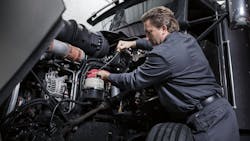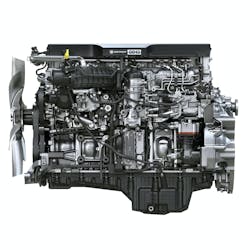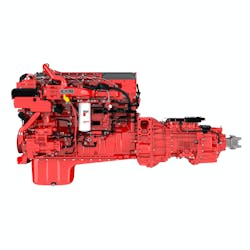The heavy-duty trucking sector still has three years before the next big flurry of emissions regulations hits in 2027. These will be the most significant changes since 2007, so fleets will need to start planning now if they haven’t already.
“It’s going to be a unique year when it comes to emissions and regulations,” said Len Copeland, product marketing manager for Detroit Diesel, which encompasses Daimler Truck North America’s drivetrain, safety, technology, and eMobility solutions. “In my 30-plus years in this industry, I’ve never seen a stack-up of emissions and vehicle requirements like we’re seeing right now.
Before getting into the equipment, here’s a quick recap of the current landscape.
Federally, the EPA determined engine OEMs must increase useful life and further reduce emissions for model year 2027 vehicles. For example, NOx emissions during normal operation will be capped at 0.035 grams per horsepower-hour.
The California Air Resources Board (CARB) has also enacted initiatives such as Advanced Clean Trucks and Advanced Clean Fleets to gradually compel fleets to purchase zero-emission vehicles. The state wants to eliminate diesel truck sales by 2035 and use by 2045. More immediately, CARB is rolling out the Clean Truck Check program this year, which calls for Class 4 and higher (>14,000 lb. GVWR) diesel trucks to pass an emissions check twice a year and pay a $30 compliance fee.
“You’ll hook up the computer via an adapter or another device, and then the inspection will proceed. Generally, it’s going to take less than five minutes to do,” Noregon Product Manager Lee Lackey explained. “That inspection can be done either via an adapter or a telematics device.”
These developments suggest some want diesel engines to go the way of the dinosaur, in spite of the technology’s ability to adapt and evolve since Copeland’s early days, driven in large part by the introduction of aftertreatment systems.
“Diesels are over 90% cleaner than they were back in 2000,” said Allen Schaeffer, executive director of the Engine Technology Forum. “We’ve gone from a tremendous 10.7 grams per brake horsepower-hour of NOx emissions down to today’s level of 0.2 … it’s very close to zero [emissions].”
He added “this 2027 rule is going to push that down another notch by another 75-80%.”
“There’s not going to be any brand-new gadgets or technology or filters that folks might have experienced 15 years ago,” Schaeffer continued, “so I think we’ll see a pretty smooth transition.”
Speaking at least for Detroit, Copeland agreed.
“These requirements are difficult, but they’re achievable—and they’re achievable using familiar diesel technologies,” he said.
These achievements come at a cost, of course. According to executives at financial services provider Hilco Global, “a 2027 EPA-compliant tractor may cost between 10% and 12% more than its predecessors.”
Read more: 2024 Class 8 truck market comes with challenges
Though maintenance departments won’t have to learn brand-new components, there will also be costs associated with training on how to operate and service these new engines. With all that in mind, the smart play will be for fleets to pre-buy MY2024-2026 trucks.
If this year’s changes are any indication, these trucks’ powertrains will provide incremental efficiency improvements while buying your fleet some extra time to meet EPA’s stricter rules.
Engine design changes
To reach those lofty regulatory goals, the emissions-scrubbing aftertreatment systems will continue doing a lot of the heavy lifting. At the same time, engines themselves will undergo changes to help hit the lower emission targets. A lot of changes have already taken place.
“Higher combustion temperatures, different piston designs, and different EGR mapping are a few ways engine manufacturers have continued meeting requirements,” said Paul Cigala, senior commercial vehicle lubricants applications engineer at ExxonMobil, whose products include the Mobil Delvac line of heavy-duty lubricants.
Cigala added that new engine designs and machining are allowing lower viscosities to run. These are increasing in popularity due to fuel-efficiency benefits.
“Just switching from a CK-4 to an FA-4 can yield a half-percent fuel economy benefit,” he noted.
Additionally, recent engine updates have been driven by a desire to enhance durability and lower the cost of ownership for fleets.
“We’ve been paying extra attention to details that reduce friction and improve fuel efficiency,” said Brian Bressler, director of aftersales for Paccar Powertrain. Examples of improvements to Paccar MX engines include better crankshaft counterweight design for greater overspeed protection, a redesigned camshaft and valvetrain to reduce weight and prioritize durability, and redesigned cylinder liners for improved component longevity.
Paccar has also changed its piston design. The amount of material was reduced to lower weight, while the shape of the piston bowl was modified to improve combustion. “We’ve even developed proprietary fuel filters to eliminate the risk of using the wrong fuel filter, thus improving the longevity of the fuel system,” Bressler added.
Mack Trucks has also modified the piston design on its MP8 engine. The waves in the piston bowl redirect flames in the combustion chamber to utilize all available oxygen for a cleaner and more complete burn. “That unique wave design delivers a 2% improvement in fuel economy and 90% reduction in soot,” said Joe Scarnecchia, powertrain sales development manager at Mack.
Ob-NOx-ious emissions rules
NOx reduction is a big part of what’s happening in 2024, largely driven by the CARB Heavy-Duty Engine and Vehicle Omnibus regulation related to low-load and idle situations.
“We’re looking at some completely new rules we’ve never faced before,” Copeland said. OEs like Detroit are also having to look at completely new types of solutions. The magic of NOx reduction has always happened at the aftertreatment system. But in low-load and idle situations, the ATS doesn’t get as hot as it needs to.
“We’re having to dose fuel in those instances, and then dose DEF to clean up the exhaust,” Copeland explained. “So this next round of NOx reductions (2024) will impact fuel consumption during extended idle. However, we believe this may ultimately have a positive effect on aftertreatment device life.”
Read more: Getting the jump on engine starting
In response, Detroit has made some modifications to its DD13 Gen5 engine, which was first introduced in 2022. “We decided to focus on this model due to its versatility across all of our product portfolio,” Copeland said. Much of the modification has taken place in the software, but a few hardware changes have been made in the ATS to make it more durable to comply with warranty rules. Due to the need to keep the ATS hotter, Detroit has also added some insulation.
At Cummins, the X15 engine has undergone several revisions to help satisfy current CARB and EPA standards.
“We also continue to look for opportunities for improvements in base engine fuel economy and through our ADEPT fuel economy features that are part of our ECM programming,” said Mark Ulrich, director of customer support at Cummins. “Helping fleets with the programming of certain engine parameters and better integration with the transmission and entire powertrain is key. Specific features like predictive cruise control can really help fleets optimize fuel economy.”
In addition, the Cummins X15 is providing onboard oil maintenance monitoring in 2024. “We’re using algorithms we’ve developed through our experience and testing,” Ulrich said. “Notifications on oil and filter life can be sent to a fleet on an asset-level basis. This is a feature we think fleets will be able to take advantage of to better schedule maintenance and reduce total cost of ownership.”
Looking ahead to 2027
Selective reduction catalysts in particular will see some enhancements. Currently, if a truck can’t get up to temperature because of stop-and-go traffic, the aftertreatment system doesn’t filter NOx as efficiently, leading to higher levels. Among the changes to look for are where in the exhaust stream the diesel exhaust fluid is dosed, and how often, explained Schaeffer, who expects engines to use “marginally more DEF to achieve some of these requirements.”
Volvo’s new VNL, out later this year, will feature a D13 engine designed to meet current and future emissions standards, with a new linear exhaust aftertreatment system that’s easier to service and delivers DEF better.
There are still some unknowns due to the constant onslaught of regulatory intrusion. Schaeffer noted that the EPA is also in the process of finalizing the Phase 3 greenhouse gas (GHG) emissions standards for heavy-duty on-highway trucks. These will impact MY2028-2032 trucks and revise certain standards for MY2027 established by the Phase 2 rule. Phase 3 was expected to be finalized by the end of 2023, but now March of this year seems more likely. This will put more pressure on OEMs to improve engine efficiency in a shorter timeframe.
On the positive side, last summer CARB and the Engine and Truck Manufacturers Association reached an agreement called the Clean Truck Partnership to harmonize California and federal NOx rules. It comprised all the major medium- and heavy-duty engine OEMs, from Cummins and Volvo to Ford and Isuzu. California had stricter levels that would limit the availability of what fleets in California could operate but now are aligned with EPA 2027 standards.
“I think that’s really good news because it takes away a lot of uncertainty from the manufacturers,” Schaeffer said. “Ultimately, I think it will result in the availability of more products.”
About the Author

Gregg Wartgow
Gregg Wartgow is a freelancer who Fleet Maintenance has relied upon for many years, writing about virtually any trucking topic. He lives in Brodhead, Wisconsin.



